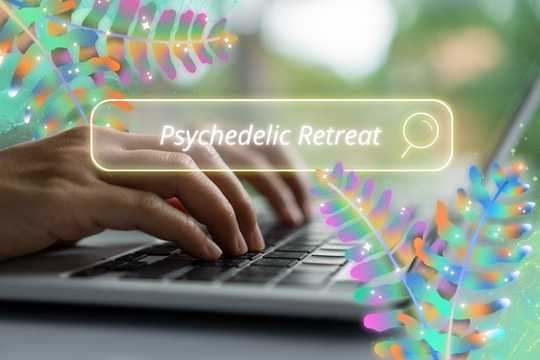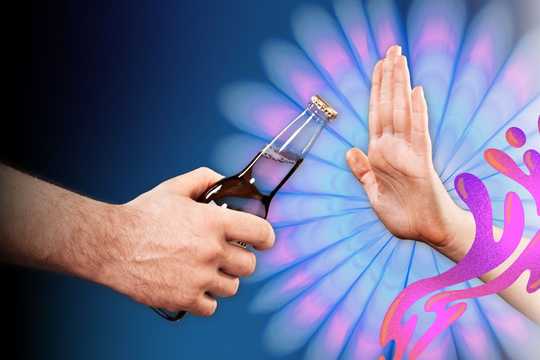DMT—also called the spirit molecule—is undoubtedly the star of the psychedelic revolution. Several plants and animals contain DMT, making it neither new nor an uncommon substance.
Ayahuasca and DMT (smokable synthesized DMT) are both popular in the newly emerging psychedelic community for those seeking healing and spiritual awakening. These substances are chemically very similar. However, there are significant differences to consider. Before committing to your psychedelic journey with any of these substances, it is vital to adopt this approach.
One of the main differences—as far as known—is that there is no traditional use of smoked DMT for healing or spiritual purposes. There are also no known shamanic practices and rituals associated with it, such as opening a sacred space. These rituals and practices are essential parts of working with these powerful psychedelic tools. They serve as protection when we enter into these vulnerable, non-ordinary states of consciousness.
Working with a traditional plant spirit like Ayahuasca is like having a personal tour guide when journeying into the unknown. In comparison, synthetic molecules such as smokeable DMT do not have this built-in quality.
In addition, extracting a single alkaloid of DMT from a complex plant is a meticulous and delicate process, much like extractions from Mimosa pudica. The process doesn’t honor the wholeness of the plant. It results in a completely different experience than one would otherwise have.
Why Is Smokeable DMT So Popular Now?
The popularity of smoking DMT for personal and spiritual exploration has grown dramatically in recent years. There are two main reasons for this.
1. Intense Psychedelic Experience
DMT is known for inducing intense psychedelic experiences characterized by a rapid onset, short duration, and a sense of ego dissolution. These experiences can contribute to healing and personal growth. However, they can also quickly become a crutch, a quick fix in response to one’s problems in life. Today’s culture promotes instant success and same-day delivery, aligning with the promise of synthesized smokeable DMT. This promise? To take a hit of DMT and meet God instantly.
The question is: “How does this help you in your everyday life in the long term?”
2. Increased Interest in Psychedelic Therapies
Broader cultural and scientific interest in the therapeutic potential of psychedelics has contributed to the popularity of substances like Ayahuasca and DMT. More and more people see it as a tool for self-discovery and therapeutic purposes.
The question is: “What are the long-term effects of its use? How sustainable and beneficial is it in the long run? What real positive results come from using this medicine?”
Potential Benefits & Harms of Smoking DMT
Most people describe their DMT smoking experience as profoundly spiritual and transformational, feeling a profound sense of connectedness with the Universe. Some people report improved mood and well-being after their experience. Still, we don’t know what measurable and sustainable positive effects the smoking of DMT truly has. His uncertainty arises because there is no tradition or documented research that we could rely on regarding this subject.
Indeed, there is interest in the potential therapeutic benefits of smokeable synthesized DMT. That said, it’s essential to emphasize that very little research is available. We have yet to understand its effects, mechanisms of action, and long-term implications. Additionally, the use of smokeable DMT carries some known risks. These include psychological distress, challenging experiences, spiritual emergencies, and potential harm to individuals with certain medical or psychiatric conditions.

Individuals considering smoking DMT for therapeutic purposes should do so with caution under the guidance of trained professionals. This practice should occur in a controlled and supportive environment.
The safe use of these powerful medicines requires expert guidance. When there is an ancestral tradition, this knowledge and guidance are passed down through generations and preserved by the elders. This preservation of knowledge is crucial to the safe and responsible use of these substances.
Ayahuasca and DMT have one crucial difference. Synthesized DMT lacks tradition and, therefore, guidance. We also need long-term experience and scientific research on this subject. Indeed, all traditions start somewhere, which may be the start of a new tradition in a new era. Still, it is wise to practice more caution when exploring a less-traveled path such as this one.
The Origins of Ayahuasca
Ayahuasca has a rich and ancient history rooted in the indigenous cultures of the Amazon Basin. It’s mainly rooted among the tribes of Peru, Ecuador, Colombia, and Brazil. The word “Ayahuasca” is derived from the Quechua language and is often translated as the “vine of the soul.”
The traditional use of Ayahuasca dates back possibly thousands of years. Indigenous communities employ the brew for spiritual, healing, and divinatory purposes. The indigenous Amazonian cultures consider Ayahuasca a powerful tool for connecting with the spirit world, receiving guidance from plant spirits, and accessing profound insights about oneself and the universe.
The Ayahuasca brew is typically prepared by combining the Banisteriopsis caapi vine—or the Ayahuasca vine—with the leaves of Psychotria viridis. Shamans or traditional healers, often referred to as “ayahuasqueros” or “curanderos,” play a crucial role in guiding individuals through ceremonies conducted in a ritualistic and ceremonial setting, typically in a specially designed space and time.
Richard Spruce published Notes of a Botanist on the Amazon and Andes in 1873. It contained the first ethnobotanical account of ayahuasca, and he reported on its sources, preparation, and effects on himself.
Of course, in the 1990s, Terrence McKenna significantly contributed to introducing Ayahuasca to the West. An example is Jeremy Narby’s widely popular book The Cosmic Serpent, published in 1998.
Many individuals worldwide now seek out Ayahuasca experiences for personal growth, healing, and spiritual exploration.
Why Ayahuasca Is the Most Popular Psychedelic
Today, one of the most researched Google search keywords in the psychedelic field is Ayahuasca Retreats.
Undoubtedly, public endorsements and testimonials from celebrities and influencers have played a role in bringing Ayahuasca into mainstream consciousness. This surge in popularity has revived revived a thousand-year-old tradition. Documentaries and media coverage exploring Ayahuasca ceremonies and individual experiences have also largely contributed to its visibility and popularity.
Still, those who work with it say they were ‘called’ by the Mother Ayahuasca to do this deep transformational work. The idea that Ayahuasca “calls” someone essentially means that they are strongly attracted to working with this plant medicine. This concept is deeply rooted in beliefs within the indigenous cultures whose ancestors worked with this medicine.
Potential Benefits & Harms of Ayahuasca
For thousands of years, people have associated the use of Ayahuasca with various documented benefits. They often use the plant as a tool for personal growth, self-discovery, and exploration of consciousness. Researchers have explored Ayahuasca as a potential therapeutic aid for various mental health conditions, including depression, anxiety, PTSD, and addiction. Studies suggest that Ayahuasca-induced psychedelic experiences can facilitate emotional processing and healing and a reevaluation and reinterpretation of traumatic experiences. People report increased self-awareness and a more remarkable ability to be present in the moment. Moreover, there are breakthrough results documented in healing following Ayahuasca experiences, especially in opiate addiction.
Some notable documented benefits are:
- Spiritual and personal growth
- Improving mental health
- Emotional release & healing
- Increased awareness & presence
- Healing of trauma
- Healing addiction
The contraindications and potential harms of Ayahuasca are also well-known and documented. This understanding is thanks to wisdom passed down through generations and the renewed interest and research in this field. Individuals with a history of certain medical or psychiatric conditions may be at increased risk when using Ayahuasca. Some examples include heart problems, schizophrenia, bipolar disorder, or a family history of psychotic disorders. You also have to be aware of specific substance interactions and certain conditions, such as pregnancy or cardiovascular disorders. And, of course, be mindful of the legal considerations when embarking on an Ayahuasca journey.
Reference this list for more specific contraindications with Ayahuasca.
Seeking guidance from experienced and reputable facilitators or shamans is vital. They can provide valuable insights and ensure a safe and supportive environment for your journey. Open communication with healthcare professionals is also essential to address any potential health concerns or medication interactions. Responsible use, informed consent, and a sacred approach are needed when we approach the Mother Plant.
Sign up and Register for FREE: Psychedelic Harm Reduction Course
Making Your Own Informed Choice
In terms of safety, individuals can approach both Ayahuasca and DMT responsibly, but the safety considerations differ.
With their longer duration and immense cultural traditions, Ayahuasca ceremonies provide a more structured and safe environment. Experienced shamans or ceremonial leaders with years of traditional training typically facilitate these ceremonies and guide participants through the experience. The presence of skilled facilitators is considered crucial for maintaining a safe and supportive environment.
On the other hand, when comparing Ayahuasca and DMT, the short duration of smoking DMT experiences may appeal more to some. Notably, it may be attractive to those seeking a potent but brief encounter with altered states of consciousness. That said, the intensity of a synthesized DMT experience can be overwhelming for some individuals. As such, it can also potentially lead to challenging psychological states. The short duration of the experience may limit the time available for participants to integrate insights and process the experience.
Ultimately, the choice between Ayahuasca and DMT should align with one’s intentions, preferences, and level of comfort. Regardless of the choice, individuals should prioritize safety and seek experienced guidance. Importantly, they should remember that one cannot bypass the deep inner work necessary to transform one’s life. While psychedelics can aid you tremendously in your healing and awakening, ultimately—you are the healer, and love is the medicine.
Stay safe on your journey!
With love, Nina Izel






